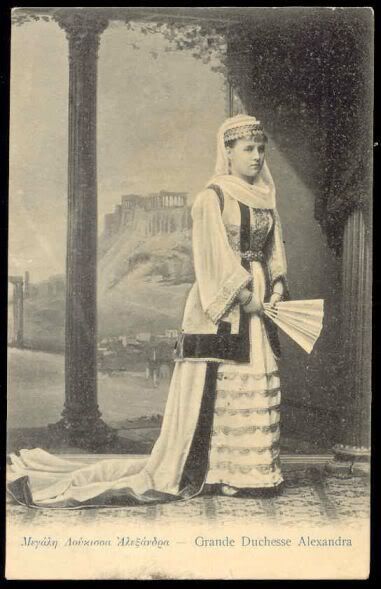Boudoir – The Court Dress of Greece
Welcome to the – hopefully –
regular edition, Boudoir! I kinda
like regular stuffs, like weekly or monthly reports and articles, so I decided
to do my own one. In Boudoir, I plan
to write about fashion, clothing, accessories and maybe sometimes Cecile will
share some tips about cosmetics and beauty-care (if she agrees to do, because I
haven’t told her my plan yet). The first issue of Boudoir is about one of my
favorite topics: the court dresses. Ladies and Gentlemen, let me introduce you
the royal court dress of Greece.
 The court dresses or court gowns
were the traditonal – and sometimes compulsory – attire in the royal and
imperial courts at important events (like weddings, opening ceremonies,
coronation, etc.), mostly in the 19th century. The 19th century was the century
of romanticism, nationalism and elegantism. The modern Greece was founded in
1832, and its first ruler was the Bavarian King Otto. I think it was really
important to emphasize that he is the king of the Greeks, he cares for his
people and respect their nationality, history and culture, since he was a „stranger”.
The king adopted the dress of the Greek partizans, the fustanella as the court
dress for males, and it symbolised the unified Greek nation as well as the
heritage of the heroes of the war of independence. King Otto’s wife was the
beautiful Princess Amalia of Oldenburg. It was the Queen, who created the
female version of the Greek national dress – still known as „Amalía dress” in
Greece.
The court dresses or court gowns
were the traditonal – and sometimes compulsory – attire in the royal and
imperial courts at important events (like weddings, opening ceremonies,
coronation, etc.), mostly in the 19th century. The 19th century was the century
of romanticism, nationalism and elegantism. The modern Greece was founded in
1832, and its first ruler was the Bavarian King Otto. I think it was really
important to emphasize that he is the king of the Greeks, he cares for his
people and respect their nationality, history and culture, since he was a „stranger”.
The king adopted the dress of the Greek partizans, the fustanella as the court
dress for males, and it symbolised the unified Greek nation as well as the
heritage of the heroes of the war of independence. King Otto’s wife was the
beautiful Princess Amalia of Oldenburg. It was the Queen, who created the
female version of the Greek national dress – still known as „Amalía dress” in
Greece. It follows the Biedermeier-style,
with a loose-fitting, white cotton or silk shirt, often decorated with lace at
the neck and handcuffs, over which a richly embroidered jacket or vest is worn,
usually of golden, dark blue or claret velvet. The skirt was ankle-length and
colourful (originally green, but changed to azure blue). It was completed with
a soft cap or fez with a single, long, golden silk tassel, traditionally worn
by married women.
It follows the Biedermeier-style,
with a loose-fitting, white cotton or silk shirt, often decorated with lace at
the neck and handcuffs, over which a richly embroidered jacket or vest is worn,
usually of golden, dark blue or claret velvet. The skirt was ankle-length and
colourful (originally green, but changed to azure blue). It was completed with
a soft cap or fez with a single, long, golden silk tassel, traditionally worn
by married women.
The „Amalía dress” and its male
version became the official attire of Greek diplomats, nobles and the royal
couple. Of course, the dress – and principally the female dress – changed with
the time and with the new fashion trends. The next Queen Consort of the Greeks,
Grand Duchess Olga Konstantinovna of Russia introduced a new court dress, which
– in my opinion – more resemble the original rural or national dresses than
the Amalía dress. It had a long skirt, a thigh-lenght coat with rich embroidery
and a metal belt. On the head they wore a special headdress with white veil and little metal disks. This kind of dress then somehow got lost between regimes and fashion trends – but the last Queen Consort, Anna-María wore (photo here) a Greek dress in the late 1960’s, which was the mixture of the Amalía dress and the Olga style dress.
by Alla
Sources: Royal Court Dress and Fashions in Greece , Linda Welters: Ethnicity in Greek Dress, Wikipedia

Comments
Post a Comment